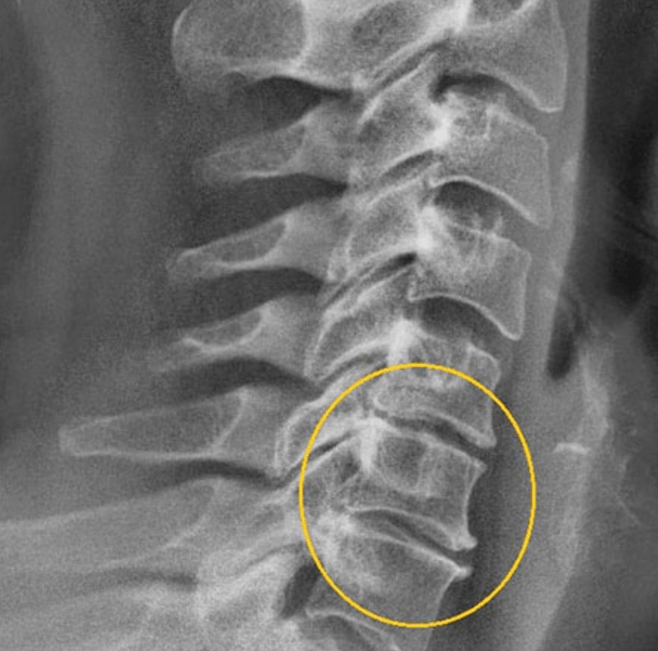The cervical spine osteochondrosis is a chronic, slowly progressive lesion of the cervical spine (from the first to the seventh), which begins with the destruction of intervertebral discs and ends with "landing", extending (hernia), a change in the form of form and degenerate.

Then, neurological (compression, inflammation of the nerves and their consequences) and vascular complications (compression of the vertebral artery and the consequences of circulatory disorders) join the clinical symptoms of osteochondrosis. With cervical osteochondrosis, these are headaches, dizziness, loss of orientation, nausea, sharp pressure spots that are difficult to normalize. Osteochondrosis is a common pathology whose symptoms up to the age of 45 are 90 % of people (regardless of gender), in front of others - for office employees who lead a sedentary lifestyle. The lesion of the cervical region is diagnosed as often as lumbar osteochondrosis. This is due to excessive neck mobility and the weakness of the muscles that surround the spine in the area.
The essence of the pathology that occurs with
The intervertebral disk (shortened MPD) is a core of water in the center and the elastic, stronger fibrous shell surrounding it. The bodies of the neighboring vertebrae are adjacent to it and below. Acceptance (and secretion) of substances and water to the intervertebral disc occurs due to diffusion (direct and reverse filtration, penetration of molecules into the disk and back) from the bone tissue of the vertebrae. The gradual aging of the intervertebral disk fabrics leads to the fact that taking the necessary substances slows down, and under the influence of provocative factors (pressure, load), it completely ceases. The dense fabric of the fibrous membrane is covered with cracks, loses its elasticity, the pulp core in the center dries (loses water). This leads to the fact that cervical osteochondrosis progresses:
Over time, the ligaments are involved in the oscillate process, they are saturated with calcium at the site of the beads and become the cause of stiffness, neck restriction. Since people continue to load the spine - they are actively moving, sit in an unpleasant position:
Such an extension is called extension (the disk shell has not yet exploded, but only changed its shape), it suppresses in adjacent tissue, which leads to the appearance of muscle tension, pain and other symptoms, with which the cervical osteochondrosis persists. Over time, the fibrous disk shell is torn, and part of the pulpica core is squeezed into the fabric (this progress is called hernia). At this stage (these are 4 stages), all acute symptoms of the disease can be immersed (a small part of the nucleus is absorbed or covered with calcium and ceases to irritate the surrounding tissue), or, conversely, will lead to the development of ischemic stroke (oxygen star, the death of a limited area).
Causes provocative factors
Considering the causes of osteochondrosis, it is worth noting that the basis of violations is the natural aging of the intervertebral disc fabrics. The process can speed up various provocative factors:
Four stages (degrees) and symptoms
With osteochondrosis in the cervical spine, all manifestations intensify from stage to stage, the more changes in the intervertebral disc - the stronger the symptoms of cervical osteochondrosis. In the initial stage of a person, the muscle tension in the neck and shoulder may be disturbed, due to which they quickly get tired. Then the main sign of the pathology appears - the pain that gives the back of the head, shoulders, arms, chest, can be masked as toothache. A person begins to think, the focus of attention is weakened, the eyesight and hearing falls, this exacerbates the quality of life and does not affect his ability to work well. Gradually, the symptoms grow and intensify - a person wakes up with the feeling of stiffness in the back, during periods of irritation any sharp movement (for example, sneezing or heel on the floor) causes a pain pain in the neck and along the affected nerves, it becomes difficult to raise your hand or keep the object in the fanatics. At night, the heartbeat can intensify or the appearance of a feeling of air deficiency may disturb-the patient cannot take a deep breath, due to the pain, a person is unable to move, turn the neck or raise his hand. In symptoms, osteochondrosis in men is almost no different from osteochondrosis in women (they often worry about headaches.
Stage 1 (Scale)
The intervertebral disc lost its elasticity and rose.
At this stage, with osteochondrosis of the cervical region, tension, fatigue, muscle fatigue and neck pain appear.
First symptoms:
Stage 2
MPD cracks, exfoliates, sags even more, elongation is formed (fibrous membrane extension), bone growths occur along the edges of the vertebrae.
Stage 3
At this stage, the explosion bursts (hernia), bone drops increase in size, ossified spine ligaments at the vertebral body attachments. Symptoms for cervical osteochondrosis in 3 phases:

Stage 4
A feature of the 4th phase - the symptoms of osteochondrosis of the cervical spine weaken, stiffness remains.
Possible complication of osteochondrosis of the cervical of the 4th degree:
Diagnostic methods
Osteochondrosis of the cervical region is diagnosed using various instrumental studies:
In the event of nervous ending damage, numerous neurological manifestations of cervical osteochondrosis occur, detect symptoms and supervise the treatment of a neurologist (helps create a diagnosis, advises, prescribes medication).
Treatment methods
Neck osteochondrosis is an incurable disease (such as osteochondrosis of any other localization), changes that occur in the intervertebral, irreversible disk tissue. In the early stages (1 and 2), it can be suspended from conservative therapy, in 3 stages of conservative treatment is prescribed to relieve acute symptoms. Sometimes with stable cervical radiculus (with inflammation of the spinal cord nucleus), surgical removal of the intervertebral discs is performed.
First aid
First aid for cervical osteochondrosis is necessary if the patient feels acute neck pain, cannot turn his head, is unable to make any other move (raise his hands). In this case, a 2%solution of anesthetics or another drug with combined properties is inserted into the muscles along the vertebrae. The blockade quickly relieves pain and improves the patient's condition. The treatment of cervical spine osteochondrosis in the recovery period is performed by heat agents that can improve blood circulation in the cervical vertebrae and neck movement.
Other methods of treatment:
Experts may recommend various orthopedic devices:
Surgical surgery
Surgical treatment may be required if:
Surgical treatment for cervical osteochondrosis significantly improves the patient's condition, but there is always the possibility of developing different complications (loss of sensitivity, spinal mobility).
Treatment at home
Home treatment of osteochondrosis is the use of products that will help:
They are used in the recovery period when the acute symptoms of the disease are left behind:
Any non -traditional method of therapy should first be discussed with the attending physician.
PREVENTION
Measures for the prevention of osteochondrosis are:
You need to pay attention to the habit of heavy carrying on one side or bag over one shoulder and escape from it. Such a unilateral load is a provocative factor in the development of cervical osteochondrosis.
Predict
Osteochondrosis is one of the most common pathologies that after 45 years appear in 90 % of people (regardless of gender). Most often diagnosed:
Violations due to which the disease occurs is irreversible, so it is impossible to cure pathology. Conservative methods can be suspended from cervical osteochondrosis in stages 1 and 2. Getting rid of acute symptoms will take 2 to 3 weeks, while complete restoration of osteochondrosis will need to be treated for up to 6 months. In stages 3 and 4, the most effective method is surgical correction (removal of hernia and discs, strengthening of beads). A prerequisite for all people after 30 years is the regular performance of special cervical spine exercises because such measures solve the problem of progressing the disease.






















